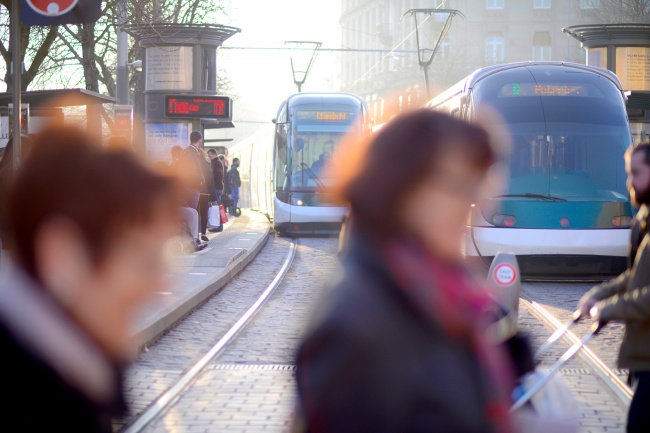

In 1994, the tram line inaugurated in Strasbourg was the first to be fitted with an integrated boarding ramp enabling easy access for wheelchair users and pushchairs. Stops were displayed on a screen but also announced over a public address system for people with visual impairments.
This was just the start of a comprehensive policy for transport accessibility for all, which can be seen today in the renovation of the existing public transport network.
Going beyond the legal requirements, all new CTS buses are equipped with two spaces for wheelchair users and a tram-style door that makes it easier to board the bus.
They are also fitted with a retractable boarding ramp so wheelchair users can board directly from the kerb.
Travel conditions for people with reduced mobility are optimised through the announcement of stops over a public address system.
The next stop and the final destination are shown on scrolling screens at all times.
Standards were updated after a new law was introduced in 2005, so all existing buses are gradually being refitted to meet the required standards. For example, stop-request buttons are being moved to the new required height.
Lastly, all the network’s bus stops are gradually being fitted out according to a charter developed by the local authority responsible for transport, the CTS (the operator) and associations for disabled people.
The charter sets out:
- Kerb height – to make it easier for wheelchair users and people who have trouble getting around (those who use a walker, for example) to get on and off;
- The width of the aisle that must remain obstacle-free and the dimensions of the turning area required for wheelchairs;
- The requirement for tactile paving enabling people with a visual impairment to identify the kerb edge;
- An approach guide line on the road so the bus can line up with the kerb more easily.
Pursuant to decree No. 2017-431 of 28 March 2017, the public accessibility registers for CTS-managed sites open to the general public can be consulted at the CTS ticket office at 9 place St Pierre le Vieux, Strasbourg. The registers cover the following four sites: Ticket office, Galerie de la Grande Verrière at the station, P+R Rotonde and P+R Rives de l'Aar.
Efforts are ongoing to provide an accessible network to as many people as possible, including people with disabilities, people experiencing temporary mobility issues, and people caring for young children, for example.
Good to know: holders of a valid CMI Invalidité disability identification card (an 80% disability card issued by the MDPH – the local council’s disabilities department) are eligible for discounted rates for monthly or yearly travel passes.
In addition, carers accompanying someone who has a CMI Invalidité card and a valid ticket can travel on CTS public transport for free.
Find out everything you need to know here.
In line with existing legal and regulatory provisions, the CTS was awarded 99 points on the gender equality index, calculated in 2024 for 2023.
The results for each indicator are as follows:
|
|
Calculable indicator (1 = yes; 0 = no) |
Final result obtained |
Number of points obtained |
Maximum number of points for the indicator |
Maximum number of points for the calculable indicator |
|
1 – Pay gap (%) |
1 |
0.3 |
39 |
40 |
40 |
|
2 – Gap in individual pay rises (%) |
1 |
0.5 |
20 |
20 |
20 |
|
4 – Percentage of staff who received a pay rise in the year after returning from maternity leave |
1 |
0.3 |
15 |
15 |
15 |
|
5 – Number of staff of the under-represented gender among the 10 highest-paid staff members |
1 |
4 |
10 |
10 |
10 |
|
Total calculable indicators |
|
99 |
|
100 |
|
|
INDEX (out of 100 points) |
99 |
100 |
|||
In addition, the share of men and women in CTS senior management for 2022 is as follows:
45.45% of women and 54.55% of men
With its mission to serve the public firmly in mind, and thanks to a wide range of fares, numerous multimodal offers and, above all, the solidarity fares introduced in 2010 by the Eurométropole, the CTS can back public transport access for all. Set up by the Eurométropole, solidarity fares are calculated based on a household’s actual resources and its composition, using the family allowance calculated by the Caisse d’Allocations Familiales (family benefits fund). In 2020, 58% of travel pass holders benefited from the scheme.
Click here for more information.
The CTS partners up with external organisations to help people understand and follow the operational rules governing the metropolitan area’s public transport. The main organisations include the associations Les Francas and Sporting Strasbourg Futsal.
The aim is to maintain an ongoing dialogue with young people and adults alike and to inform them about various issues, especially safety, so they behave in a way that complies with transport regulations.
5,256 young people were informed about what it means to be a responsible citizen on public transport in 2021!
The CTS has chosen to place sustainable development at the heart of what it does. It is constantly trying to improve its public transport offer to serve the inhabitants of the Strasbourg metropolitan area while keeping costs down.
It is also showing the city how to safeguard environmental balances. Lastly, the project also promotes good citizenship because it combines the company’s driving force with its development policy while improving accessibility for all and making it easier for people to enjoy using public transport in the Eurométropole de Strasbourg.
Promoting biodiversity in the city centre
The CTS continues to show its commitment to the environmental arm of its sustainable development policy by making every effort to safeguard biodiversity in the city.
For many years the CTS has pursued an ambitious, proactive policy to protect the environment. Since 2015, this commitment has been reflected in initiatives to encourage biodiversity in the city. For example, a bug hotel and three beehives managed by beekeepers from the Asapistra association have been installed at the Kibitzenau depot.
By helping to protect bees (which are currently under threat), the CTS has joined a global – and local – drive to care for the environment. The city of Strasbourg (and by extension its Eurométropole) is known and recognised worldwide for its dedication to safeguarding the environment, as evidenced by its Capitale française de la biodiversité (French capital of biodiversity) certification.
The city has written a charter titled Tous unis pour + de biodiversité (United to increase biodiversity), which aims to commend and support environmental actions taken by businesses and public space actors working to preserve nature in urban areas. To sign the charter, applicants must meet at least six of the fifteen or so criteria listed by the local authority. The CTS – fully eligible with eight initiatives – signed the charter on 7 July 2015.
Eight actions commended by the Tous unis pour + de biodiversité charter:
* Discontinuing the use of chemicals to kill weeds
* Using alternative weed management techniques
* Reducing grass cutting (two cuts per year)
* Mulching flowerbeds to reduce watering
* Creating a bee-friendly meadow
* Planting fruit trees
* Installing a bug hotel
* Installing beehives

When the CTS decided to change the appearance and fittings of its new buses in 2011, it was primarily concerned with saving money.
Ultimately, however, the project also inspired the CTS to come up with a new way to assume its role as a socially responsible company.
New buses are now decorated with artwork by artists based in Strasbourg or with a strong connection to the city. The CTS is careful to alternate promoting heritage with giving a platform to young artists.
At first glance, public transport and art seem unlikely partners. But look more closely and you’ll find that art is part of the history of Strasbourg’s transport network and the CTS.
The return of the tram in 1994 paved the way for a fresh interpretation of Strasbourg and its neighbourhoods. The landscape was redrawn while preserving its traditional heritage. To emphasise the latter while highlighting the city’s modernity and flourishing new transport network, the council of Strasbourg's urban community decided to install artworks along the tram infrastructure.














